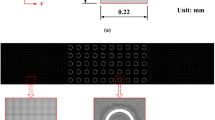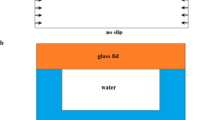Abstract
Microbioreactors have been widely utilized as an alternative to conventional benchtop reactors, since the miniaturized platforms offer advantages including reduced sample volume and homogeneous microenvironments. Here, we proposed an acoustofluidic microbioreactor based on surface acoustic wave (SAW)-induced acoustic streaming flow (ASF). The SAW-induced ASF, which originates from the wave attenuation in a fluid, allows rapid mixing and heat transfer for enhanced mass and heat transfer within the sample fluid. We conducted thorough numerical and experimental investigations on the acousto-hydrodynamics and heat transfer phenomena to find an optimal frequency in the prescribed cylindrical microwell. We found that the homogenous chemical concentration and temperature distributions within the fluid were rapidly achieved by the SAW-induced ASF in the proposed device. For proof-of-concept demonstration of practical applicability, we cultured Escherichia coli as a model cell using the proposed acoustofluidic microbioreactor. From comparative evaluation with conventional platforms including a shaker incubator and a microplate shaker, we confirmed that the bacteria growth rate was enhanced in the proposed acoustofluidic microbioreactor due to the high homogeneity in the chemical concentration and temperature by the acoustic agitation, without any moving mechanical components. We expect that the proposed ASF-based microbioreactor can be broadly utilized for various biological applications that require homogeneous mixing and temperature gradient within a reaction medium.







Similar content being viewed by others
Data availability
The data that support the findings of this study are available from the corresponding author upon reasonable request.
References
Song, Y., et al.: Microfluidic synthesis of nanomaterials. Small 4, 698–711 (2008)
Zhang, X., et al.: Application of microreactor technology in process development. Org. Process Res. Dev. 8, 455–460 (2004)
Kim, S., et al.: Acoustofluidic stimulation of functional immune cells in a microreactor. Adv. Sci. 9, 2105809 (2022)
Meyvantsson, I., et al.: Cell culture models in microfluidic systems. Annu. Rev. Anal. Chem. 1, 423–449 (2008)
Mason, B.P., et al.: Greener approaches to organic synthesis using microreactor technology. Chem. Rev. 107, 2300–2318 (2007)
Schäpper, D., et al.: Application of microbioreactors in fermentation process development: a review. Anal. Bioanal. Chem. 395, 679–695 (2009)
Liu, Y., et al.: Why microfluidics? Merits and trends in chemical synthesis. Lab Chip 17, 3960–3978 (2017)
Halldorsson, S., et al.: Advantages and challenges of microfluidic cell culture in polydimethylsiloxane devices. Biosens. Bioelectron. 63, 218–231 (2015)
Sebastian Cabeza, V., et al.: Size-controlled flow synthesis of gold nanoparticles using a segmented flow microfluidic platform. Langmuir 28, 7007–7013 (2012)
Kwizera, E.A., et al.: Greatly enhanced CTC culture enabled by capturing CTC heterogeneity using a PEGylated PDMS–Titanium–Gold electromicrofluidic device with glutathione-controlled gentle cell release. ACS Nano 16, 11374–11391 (2022)
Zhang, Z., et al.: Microchemostat—microbial continuous culture in a polymer-based, instrumented microbioreactor. Lab Chip 6, 906–913 (2006)
Pasirayi, G., et al.: Microfluidic bioreactors for cell culturing: a review. Micro Nanosyst. 3, 137–160 (2011)
Kim, R.: Advanced organotypic in vitro model systems for host-microbial coculture. BioChip J. (2023). https://doi.org/10.1007/s13206-023-00103-5
Figallo, E., et al.: Micro-bioreactor array for controlling cellular microenvironments. Lab Chip 7, 710–719 (2007)
Lee, Y., et al.: Microfabricated cell culture system for the live cell observation of the multilayered proliferation of undifferentiated HT-29 cells. BioChip J. 11, 308–315 (2017)
Lee, K.W., et al.: Immunogenicity monitoring cell chip incorporating finger-actuated microfluidic and colorimetric paper-based analytical functions. BioChip J. (2023). https://doi.org/10.1007/s13206-023-00111-5
Marimuthu, M., et al.: Continuous oxygen supply in pump-less micro-bioreactor based on microfluidics. BioChip J. 9, 1–9 (2015)
Grünberger, A., et al.: A disposable picolitre bioreactor for cultivation and investigation of industrially relevant bacteria on the single cell level. Lab Chip 12, 2060–2068 (2012)
Connacher, W., et al.: Micro/nano acoustofluidics: materials, phenomena, design, devices, and applications. Lab Chip 18, 1952–1996 (2018)
Huang, G., et al.: Combining ultrasound-mediated intracellular delivery with microfluidics in various applications. BioChip J. (2023). https://doi.org/10.1007/s13206-023-00128-w
Cha, B., et al.: Rapid acoustofluidic mixing by ultrasonic surface acoustic wave-induced acoustic streaming flow. Ultrason. Sonochem. 99, 106575 (2023)
Wiklund, M.: Acoustofluidics 12: biocompatibility and cell viability in microfluidic acoustic resonators. Lab Chip 12, 2018–2028 (2012)
Greco, G., et al.: Surface-acoustic-wave (SAW)-driven device for dynamic cell cultures. Anal. Chem. 90, 7450–7457 (2018)
Im, Y., et al.: Antibiotic susceptibility test under a linear concentration gradient using travelling surface acoustic waves. Lab Chip 21, 3449–3457 (2021)
Kim, W., et al.: Acoustofluidic control of chemical concentration within picoliter droplets in a disposable microfluidic chip. Sens. Actuators B Chem. 393, 134132 (2023)
Stringer, M., et al.: Methodologies, technologies, and strategies for acoustic streaming-based acoustofluidics. Appl. Phys. Rev. 10, 011315 (2023)
Laurell, T., Lenshof, A.: Microscale acoustofluidics. Royal Society of Chemistry, London (2014)
Rasouli, R., et al.: Acoustofluidics–changing paradigm in tissue engineering, therapeutics development, and biosensing. Lab Chip 23, 1300–1338 (2023)
Markham, J.J., et al.: Absorption of sound in fluids. Rev. Mod. Phys. 23, 353 (1951)
Collins, D.J., et al.: Highly localized acoustic streaming and size-selective submicrometer particle concentration using high frequency microscale focused acoustic fields. Anal. Chem. 88, 5513–5522 (2016)
Dentry, M.B., et al.: Frequency effects on the scale and behavior of acoustic streaming. Phys. Rev. 89, 013203 (2014)
Park, J., et al.: Acoustofluidic generation of droplets with tunable chemical concentrations. Lab Chip 20, 3922–3929 (2020)
Song, S., et al.: Design of interdigitated transducers for acoustofluidic applications. Nanotechnol. Precis. Eng. (2022). https://doi.org/10.1063/10.0013405
Naas, T.T., et al.: High performance in terms of thermal mixing of non-Newtonian fluids using open chaotic flow: numerical investigations. Therm. Sci. Eng. Prog. 16, 100454 (2020)
Moffatt, H.K.: The degree of knottedness of tangled vortex lines. J. Fluid Mech. 35, 117–129 (1969)
Park, J., et al.: Acoustothermal tweezer for droplet sorting in a disposable microfluidic chip. Lab Chip 17, 1031–1040 (2017)
Park, J., et al.: Spatiotemporally controllable acoustothermal heating and its application to disposable thermochromic displays. RSC Adv. 6, 33937–33944 (2016)
Shilton, R.J., et al.: Rapid and controllable digital microfluidic heating by surface acoustic waves. Adv. Funct. Mater. 25, 5895–5901 (2015)
Alvarez, M.M., et al.: Laminar mixing in eccentric stirred tank systems. Can. J. Chem. Eng. 80, 546–557 (2002)
Ratkowsky, D.A., et al.: Relationship between temperature and growth rate of bacterial cultures. J. Bacteriol. 149, 1–5 (1982)
Van Alst, A.J. (2016) Growth curves: generating growth curves using colony forming units and optical density measurements. MyJoVE corporation. https://www.jove.com/v/10511/growth-curves-generating-growth-curves-usingcolony-forming-units. Accessed 11 Jan 2024
Au, S.H., et al.: Integrated microbioreactor for culture and analysis of bacteria, algae and yeast. Biomed. Microdevices 13, 41–50 (2011)
Piella, J., et al.: Size-controlled synthesis of sub-10-nanometer citrate-stabilized gold nanoparticles and related optical properties. Chem. Mater. 28, 1066–1075 (2016)
Acknowledgements
This work was supported by the National Research Foundation of Korea (NRF) grant funded by the Korea government (MSIT) (RS-2023-00210891). The microfluidic devices were fabricated by using a mask aligner (MDA-400S, MIDAS) at Energy Convergence Core Facility in Chonnam National University.
Author information
Authors and Affiliations
Corresponding authors
Additional information
Publisher's Note
Springer Nature remains neutral with regard to jurisdictional claims in published maps and institutional affiliations.
Supplementary Information
Below is the link to the electronic supplementary material.
Rights and permissions
Springer Nature or its licensor (e.g. a society or other partner) holds exclusive rights to this article under a publishing agreement with the author(s) or other rightsholder(s); author self-archiving of the accepted manuscript version of this article is solely governed by the terms of such publishing agreement and applicable law.
About this article
Cite this article
Cha, B., Lee, S., Park, G. et al. Acoustofluidic Microbioreactor Using Surface Acoustic Wave-induced Acoustic Streaming Flow. BioChip J (2024). https://doi.org/10.1007/s13206-024-00148-0
Received:
Revised:
Accepted:
Published:
DOI: https://doi.org/10.1007/s13206-024-00148-0




